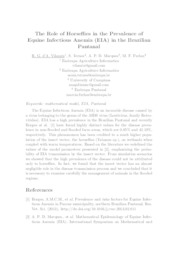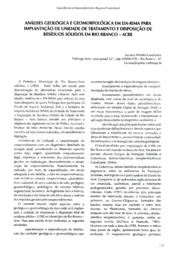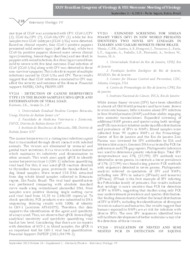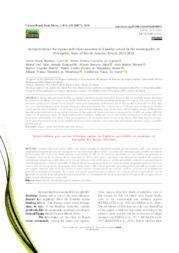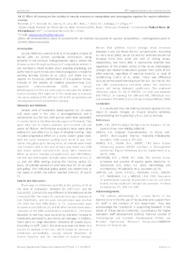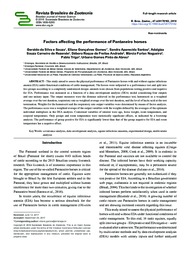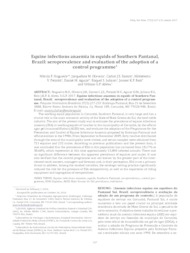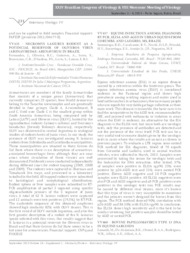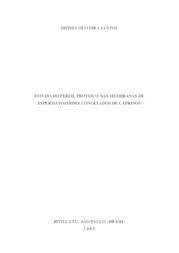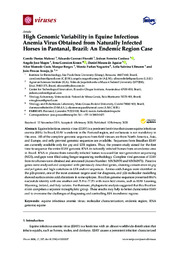Search Publications
Filter by:
| Author(s): VILAMIU, R. G. d´A.; TERNES, S.; MARQUES, A. P. D.; FURLAN, M. F. The Equine Infectious Anemia (EIA) is an incurable disease caused by a virus belonging to the genus of the AIDS virus (Lentivirus, family Retroviridae). EIA has a high prevalence in the Brazilian Pant... ... |
| Author(s): CAVALCANTE, L. M. O presente resumo expões aspectos sobre a geologia e a geomorfologia da área onde será implantada a unidade de tratamento e disposição final de resíduos sólidos - UTRE no município de Rio Branco - Acr... ... |
| Author(s): CAVALCANTE, R. V.; NOGUEIRA, M. F.; ARAÚJO Jr. J. P. Equine infectious anemia (EIA) is caused by a retrovirus and its primary mode of transmission comprises transfer of blood from infected animals to healthy ones. In Brazil, EIA notification is mandator... ... |
| Author(s): CRUZ, A. P. M.; AQUINO, M. H. C. de; HELAYAEL, M. J. S. A.; SILVA, M. R.; RIBEIRO, J. B.; HOTT, M. C.; MAGALHAES JUNIOR, W. C. P. de; MENDONÇA, J. F. M. de; SOUZA, G. N. de Equine infectious anaemia (EIA) is a globally distributed disease caused by a lentivirus. EIA is a notifiable disease that should be reported to the Official Veterinary Service (SVO). Outbreaks are co... ... |
| Author(s): REZENDE, A.; ANDRADE, D.; SANTOS, S. A.; NOGUEIRA, M. F.; REIS, L.; MELO, M.; SANTIAGO, J.; TRIGO, P. Equine infectious anemia (EIA) is an incurable disease of equids with an almost worldwide distribution, being endemic in the Pantanal Matogrossense region, where the disease control through euthanasia... ... |
| Author(s): SOUZA, G. da S. e; GOMES, E. G.; SANTOS, S. A.; REZENDE, A. S. C. de; ANDRADE, D. R. de F.; NOGUEIRA, M. F.; TRIGO, P.; ABREU, U. G. P. de This study aimed to assess the physical performance of Pantaneiro horses with and without equine infectious anemia (EIA) under functional conditions of cattle management. The horses were subjected to... ... |
| Author(s): NOGUEIRA, M. F.; OLIVEIRA, J. M.; SANTOS, C. J. S.; PETZOLD, H. V.; AGUIAR, D. M.; JULIANO, R. S.; REIS, J. K. P.; ABREU, U. G. P. de The working equid population in Corumbá, Southern Pantanal, is very large and has a crucial role in the main economic activity of the State of Mato Grosso do Sul, the beef cattle industry. The aim of... ... |
| Author(s): SAMANIEGO, R. D.; CAVALCANTE, R. V.; NOCITI, D. L. P.; PETZOLD, H. V.; ESNARRIAGA, E. S.; ARAÚJO JR. J. P.; NOGUEIRA, M. F. Equine infectious anemia (EIA) is an equine disease caused by a retrovirus within the lentivirus genus. The equine infectious anemia virus (EIAV) is considered endemic in the Pantanal region and shows... ... |
| Author(s): SANTOS, D. O. Resumo: O presente estudo identificou o pertll protéico da membrana plasmática dos espermatozóides, congelados, de caprinos, através de eletroforese bidimensional (2-D). O objetivo foi encontrar prote... ... |
| Author(s): MALOSSI, C. D.; FIORATTI, E. G.; CARDOSO, J. F.; MAGRO, A. J.; KROON, E. G.; AGUIAR, D. M. de; BORGES, A. M. C. M; NOGUEIRA, M. F.; ULLMANN, L. S.; ARAUJO JUNIOR, J. P. Equine infectious anemia virus (EIAV) is a persistent lentivirus that causes equine infectiousanemia (EIA). In Brazil, EIAV is endemic in the Pantanal region, and euthanasia is not mandatory inthis ar... ... |
Observation
Some of Embrapa's publications are published as ePub files. To read them, use or download one of the following free software options to your computer or mobile device. Android: Google Play Books; IOS: iBooks; Windows and Linux: Calibre.
Access other publications
Access the Agricultural Research Database (BDPA) to consult Embrapa's full library collection and records.
Visit Embrapa Bookstore to purchase books and other publications sold by Embrapa.

